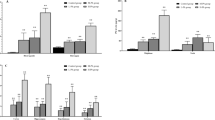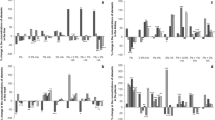Abstract
The effects of Pb ingestion with and without concurrent dietary Cu supplementation were determined on parameters associated with Cu deficiency in rats fed a nutritionally adequate diet. Groups of weanling male Sprague-Dawley rats were fed a purified (AIN-′76) diet and given Pb (0 or 500 ppm) and Cu (0, 6, or 12 ppm) as the acetate salt in deionized drinking water for 5 wk. A Pb-induced Cu deficiency resulted that was characterized by decreased levels of Cu in tissue and blood, decreased activities of the Cu-dependent enzymes, ceruloplasmin (serum) and Superoxide dismutase (erythocytes), and increased concentration of Fe in liver. These effects of Pb were prevented completely or in part by concurrent Cu supplementation. The Pb-induced decrease in hemoglobin and hematocrit values and the decrease in weight gain were not prevented by Cu supplementation of the diet and can therefore be assumed to be the direct result of a toxic effect of Pb. Although Pb ingestion resulted in decreased concentration of Cu in blood and tissue, additional dietary Cu had no effect on Pb levels.
Similar content being viewed by others
References
C H. Hill inTrace Elements in Human Health and Disease, vol. 2, A. S. Prasad and D. Oberleas, eds., Academic, New York, 1976, pp. 288–300.
H. G. Petering,Environ. Health Perspect. 25, 141 (1978).
M. Kirchgessner, F. J. Schwarz, N. E. Grassman, and H. Steinhart inCopper in the Environment. Part II: Health Effects, J. O. Nriagu, ed. J. Wiley and Sons, New York, 242, 1979, pp, 434–471.
D. S. Klauder, L. Murthy, and H. G. Petering inTrace Substances in Environmental Health, vol. 6, D. D. Hemphill, ed., University of Missouri, Columbia Missouri, 1972, pp. 131–136.
D. S. Klauder and H. G. Petering,J. Nutr. 107, 1779 (1977).
A. A. Mylroie, H. Collins, G. Hill, and L. Austin inTrace Substances in Environmental Health, vol. 10, D. D. Hemphill, ed., University of Missouri, Columbia, Missouri, 1982, pp. 305–309.
A. A. Mylroie, J. Kyle, and C. Umbles,An Effect of Copper Supplementation on Superoxide Dismutase Activity in Liver and Kidney of Rats Ingesting Lead Acetate,Am. Chem. Soc. Abstract (1984).
American Institute of Nutrition,J. Nutr. 107, 1340 (1974).
H. P. Misra and I. Fridovich,Arch. Biochem. Biophys. 183, 308 (1977).
D. I. Paynter, R. J. Moir, and E. J. Underwood,J Nutr. 109, 1570 (1979).
E. W. Rice,Anal. Biochem. 3, 452 (1962).
Instrumentation Laboratory Operator–s manual, Lexington, MA, 1970, pp. 22–31.
F. J. Fernandez and H. L. Kahn,Clin. Chem. Newslett. 3, 24 (1971).
D. Drabkin and H. Austin,J. Biol. Chem. 112, 51 (1935).
N. Nie, H. D. Bent, and C. H. Hull,Statistical Package for the Social Sciences, F. F. Dojny, ed., McGraw-Hill, New York, 1970.
J. L. Evans and P. A. Abraham,J. Nutr. 103, 196 (1973).
W. Bohnenkamp and U. Weser, inSuperoxide and Superoxide Dismutase, A. M. Michelson, J. M. McCord, and I. Fridovich, eds., Academic, New York, 1977, pp, 387–394.
M. R. Moore, P. A. Meredith, and A. Goldberg inLead Toxicity, R. L. Singhal and J. A. Thomas, eds., Urban and Schwarzenberg, Baltimore, MD, 1980, pp. 79–118.
S. Osaki, D, A. Johnson, and E. Frieden,J. Biol. Chem. 241, 2746 (1966).
E. Frieden, inCopper in the Environment. Part II: Health Effects, J. O. Nriagu, ed., J. Wiley and Sons, New York, 1979, pp. 242–283.
E. Frieden, inInflammatory Diseases and Copper, J. R. J. Sorenson, ed., Humana, Clifton, NJ, 1982, pp. 159–170.
I. Fridovich,Ann. Rev. Biochem. 44, 147 (1971).
F. L. Cerklewski and R. M. Forbes,J. Nutr. 107, 143 (1977).
B. B. Gelman, I. A. Michaelson, and J. S. Bus,Toxicol. Appl. Pharmacol. 45, 119 (1978).
Author information
Authors and Affiliations
Rights and permissions
About this article
Cite this article
Mylroie, A.A., boseman, A. & Kyle, J. Metabolic interactions between lead and copper in rats ingesting lead acetate. Biol Trace Elem Res 9, 221–231 (1986). https://doi.org/10.1007/BF02988821
Received:
Accepted:
Issue Date:
DOI: https://doi.org/10.1007/BF02988821




